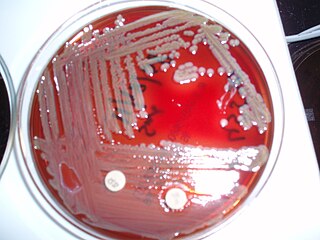| Sphingobacteriales | |
|---|---|
| Scientific classification | |
| Domain: | Bacteria |
| Phylum: | Bacteroidota |
| Class: | Sphingobacteriia |
| Order: | Sphingobacteriales Kämpfer 2012 [1] |
| Families [2] [3] | |
| |
The Sphingobacteriales is an order of environmental bacteria. [4] [5]
| Sphingobacteriales | |
|---|---|
| Scientific classification | |
| Domain: | Bacteria |
| Phylum: | Bacteroidota |
| Class: | Sphingobacteriia |
| Order: | Sphingobacteriales Kämpfer 2012 [1] |
| Families [2] [3] | |
| |
The Sphingobacteriales is an order of environmental bacteria. [4] [5]

The phylum Bacteroidota is composed of three large classes of Gram-negative, nonsporeforming, anaerobic or aerobic, and rod-shaped bacteria that are widely distributed in the environment, including in soil, sediments, and sea water, as well as in the guts and on the skin of animals.

Bacteroidales is an order of bacteria. Notably it includes the genera Prevotella and Bacteroides, which are commonly found in the human gut microbiota.
Rikenellaceae is a family of bacteria. Members of this family are often found in the gastrointestinal tract of a number of different animals.
Porphyromonadaceae is a family of bacteria.
Prevotellaceae is a family of bacteria from the order Bacteroidales. As a member of the phylum Bacteroidota, it's species are gram negative - meaning their outer cell wall contains lipopolysaccharides. Since they are anaerobes, members of Prevotellaceae can live in areas where there is little to no oxygen - such as the guts of mammals.

The class Flavobacteriia is composed of a single order of environmental bacteria. According to Bernardet et al., Flavobacteriia are Gram-negative aerobic rods, 2–5 μm long, 0.3–0.5 μm wide, with rounded or tapered ends that are motile by gliding, yellow colonies on agar, decompose several polysaccharides but not cellulose, G+C contents of 32–37%, and are widely distributed in soil and fresh and seawater habitats. In particular, Flavobacteriia are prominent members of marine biofilms. The type species Flavobacterium aquatile was isolated from a well in Kent, England.
Sphingobacteriia is a taxonomic class composed of a single order of environmental bacteria that are capable of producing sphingolipids. The earlier name Sphingibacteria was changed in 2011.

The order Flavobacteriales comprises several families of environmental bacteria.
The family Saprospiraceae is composed of environmental bacteria. The members of this family are important to the breakdown of complex organic compounds in the environment.

The Acidobacteriaceae are a family of Acidobacteriota.
Bergey's Manual of Systematic Bacteriology is the main resource for determining the identity of prokaryotic organisms, emphasizing bacterial species, using every characterizing aspect.
Blattabacterium is a genus of obligate mutualistic endosymbiont bacteria that are believed to inhabit all species of cockroach studied to date, with the exception of the genus Nocticola. The genus' presence in the termite Mastotermes darwiniensis led to speculation, later confirmed, that termites and cockroaches are evolutionarily linked.
The Marinilabiliaceae are a family of bacteria.
Sneathia is a Gram-negative, rod-shaped, non-spore-forming and non-motile genus of bacteria from the family of Leptotrichiaceae. Species have been identified as pathogens associated with bacterial vaginosis.
The Rhodothermaceae are a family of bacteria.
Saprospirales is an order of bacteria in the phylum Bacteroidota.
Cyclobacteriaceae is a family of bacteria in the phylum Bacteroidota.
Planctomycetia is a class of aquatic bacteria.
"Candidatus Brocadia" is a candidatus genus of bacteria. Many of the species in this genus are capable of anammox.

The "Acidobacteriia" is a class of Acidobacteriota.